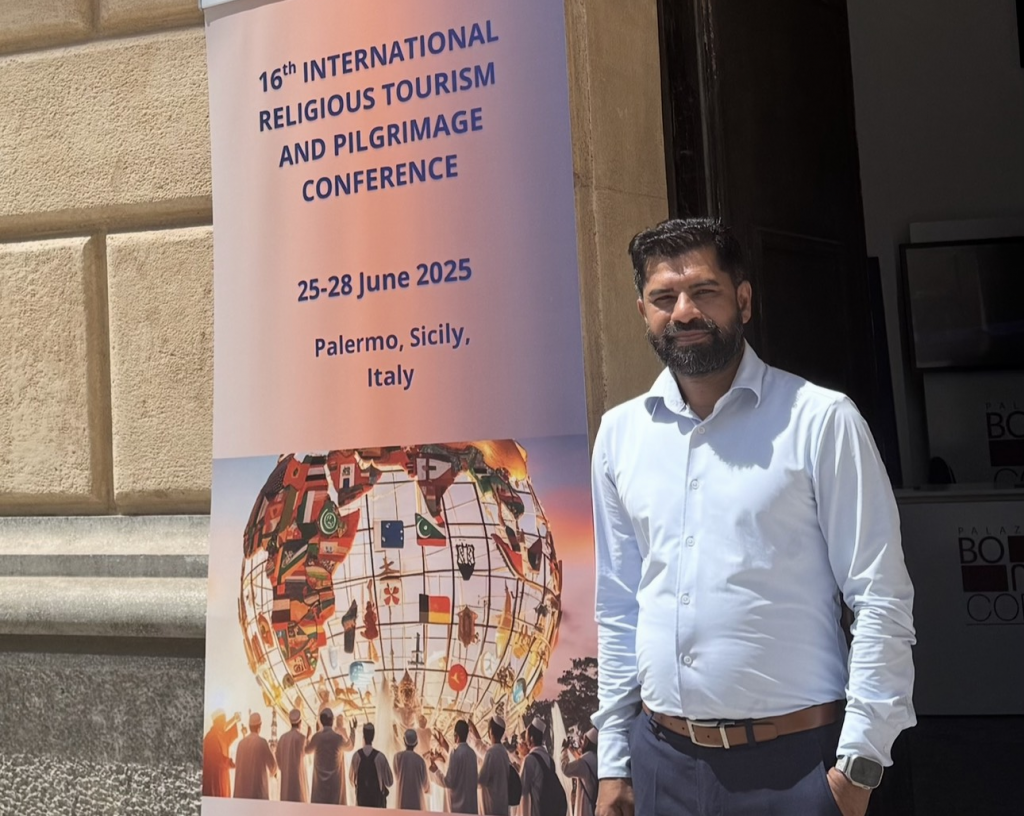Dr Javed Kawsar, Lecturer in Marketing at Salford Business School, recently presented his latest research at the 16th International Religious Tourism and Pilgrimage (IRTP) Conference 2025, held at the University of Palermo in Sicily, Italy.
The conference brought together academics, researchers, practitioners, and policymakers to explore the evolving field of religious tourism and pilgrimage. As faith-based travel continues to intersect with digital innovation, Dr Kawsar’s presentation offered a timely and thought-provoking contribution to the debate.
About the research
Titled “Virtual reality and multifaith pilgrimage: assessing the impact of VR technology on religious tourism across different traditions,” Dr Kawsar’s work examined how virtual reality (VR) is reshaping spiritual journeys that have historically relied on physical presence and communal experience.
For centuries, religious tourism has been deeply rooted in physical presence and spiritual immersion—pilgrims travelling across the world to visit sacred sites like Mecca, the Vatican, Varanasi, or Jerusalem. These journeys often represent more than just travel; they are acts of faith, reflection, and communal experience. But with the rise of virtual reality (VR) technology, a new chapter is unfolding—one where sacred experience can be accessed without ever leaving home.
Imagine exploring the Western Wall in Jerusalem, walking through the Vatican, or experiencing the sacred ghats of Varanasi, all through a VR headset. From Hajj simulations for Muslims to immersive journeys through Buddhist Lumbini, VR is making these deeply spiritual spaces more accessible to people who face physical, financial, or geopolitical barriers. For some, this is a game-changer—opening doors that were once closed due to health issues, costs, or international restrictions.
Key questions raised
While virtual reality offers a new way to learn about, and connect with, faith traditions, it raises some profound questions:
- Can a digital experience ever truly replace the emotional depth of being there in person?
- What happens to the rituals, smells, sounds, and community interactions that define real pilgrimages?
- Is it ethical to digitise sacred spaces for commercial or casual use?
Critics argue that something essential is lost when you remove the physical, communal, and transformative elements of pilgrimage. After all, many faith traditions place significant spiritual value on the act of travel and personal sacrifice.
Insights and implications
Recent studies are now delving into the real impact of VR on religious tourism. By exploring case studies across multiple faiths—including Islam, Christianity, Hinduism, Buddhism, and Judaism—researchers are analysing how VR:
- Enhances spiritual engagement for users
- Increases accessibility
- Helps preserve religious heritage through digital recreation
At the same time, they’re also identifying risks: from digital exclusion (not everyone has access to this tech) to the commercialisation of sacredness, and the potential loss of authenticity in virtual worship.
Dr Kawsar said: “VR isn’t here to replace religious travel—it’s here to compliment it. As technology continues to evolve, the real opportunity may lie in blending physical and digital experiences—allowing more people to connect with the sacred while still honouring the traditions that make pilgrimage meaningful.”
Looking ahead
As religious tourism adapts to a digital era, Dr Kawsar’s research highlights the need for thoughtful dialogue between technologists, faith leaders, and policymakers. The journey might be virtual, but the questions it raises are very real.
